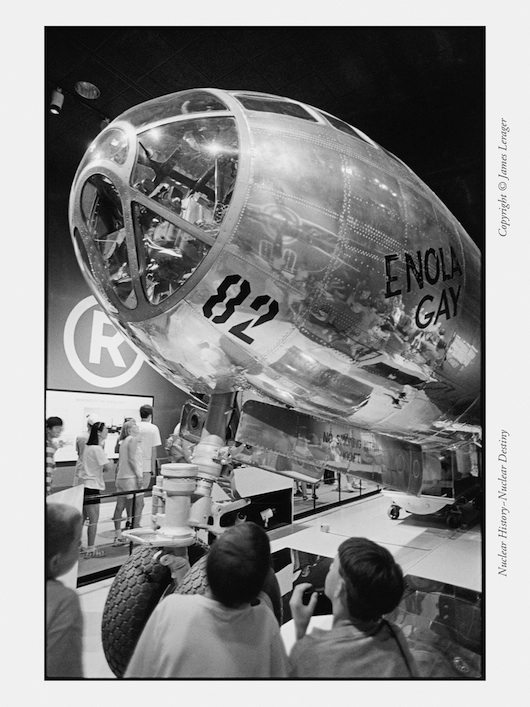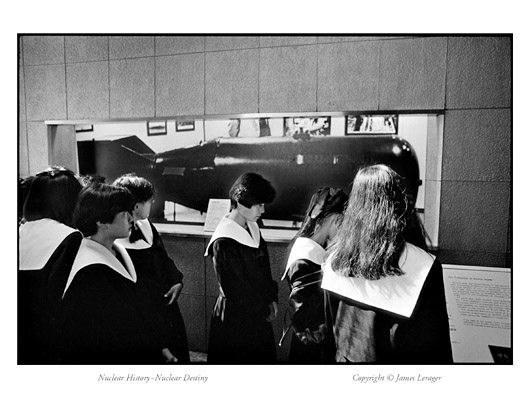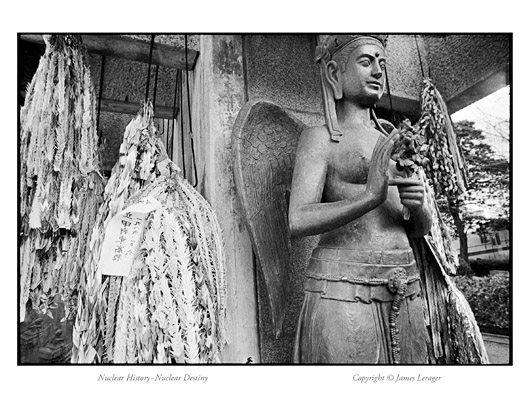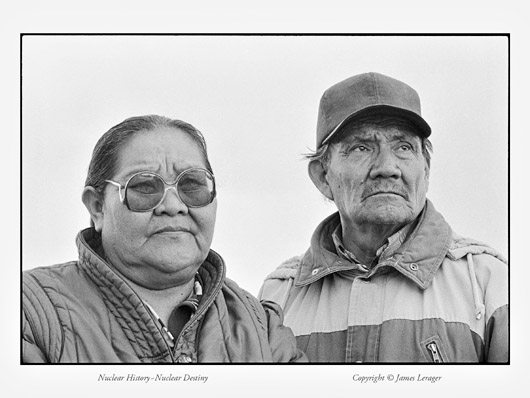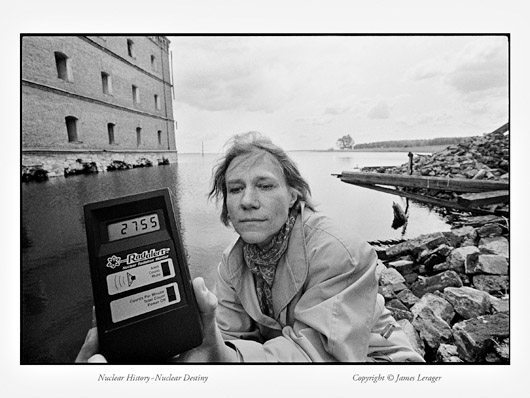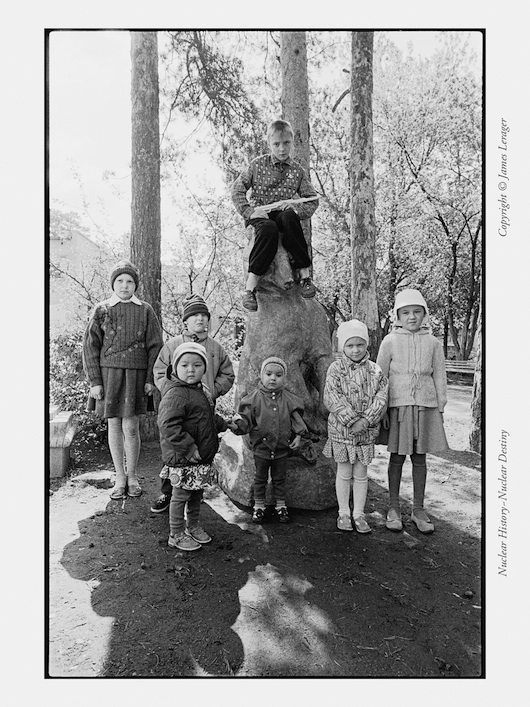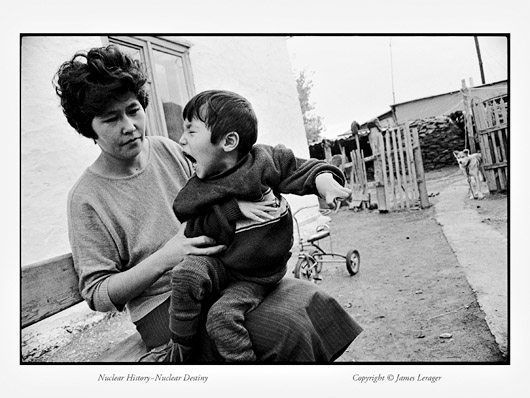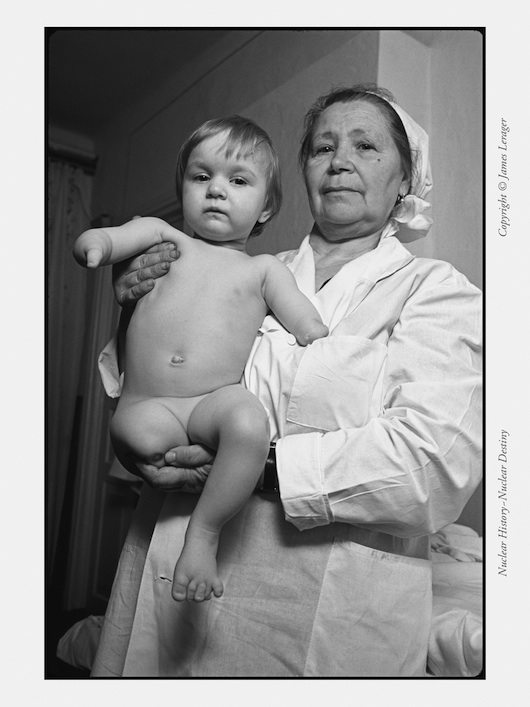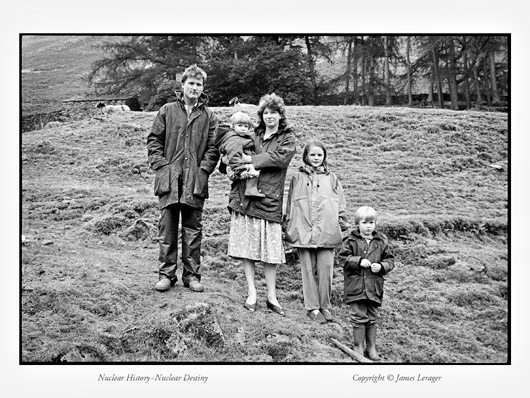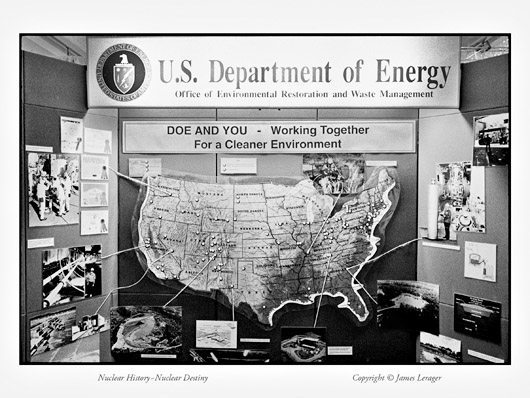In the 1950s, Major Hank Henry was one of the top fighter-bomber pilots in the United States Air Force, and a member of the 4925th Test Group (Atomic). At the group´s 1986 reunion, he mounted one of “his” nuclear weapons, the casing for a 500-kiloton atomic bomb, on display at the National Atomic Museum.
The Enola Gay, the B-29 that dropped the atomic bomb on Hiroshima on August 6, 1945, was installed in the Smithsonian Institute’s National Air & Space Museum in Washington D.C. in the summer of 1995, commemorating the 50th anniversary of the nuclear bombing of Japan. Some of the exhibition materials, prepared by historians, questioned whether, with the benefit of hindsight, dropping nuclear weapons on Japanese cities had been necessary or wise.
A replica, exhibited in the Hiroshima Peace Museum, of the ‘Little Boy’ atomic bomb that destroyed Hiroshima on August 6, 1945. ‘Little Boy’ was fabricated from uranium. The ‘Fat Man’ bomb that was detonated over Nagasaki three days later used plutonium for its explosive power.
A memorial with folded paper cranes in Hiroshima Peace Park. Sadako Sasaki, now a figure of legend, was two years old when Hiroshima was bombed. Ten years later Sadako was diagnosed with leukemia. She had faith in an ancient Japanese proverb, believing that if she folded 1,000 paper cranes, she would regain her health. When she died in 1955, she is had folded 650 cranes. Today, Sadako and her paper cranes have become an international symbol for peace, and the dream that nuclear weapons will never again be used in war. Many memorials in Hiroshima are covered with paper cranes, sent to Hiroshima from all over Japan and the world.
Frenchman’s Flat, on the Nevada Test Site, where the U.S. conducted most of its atmospheric nuclear weapons tests in the 1950s and early 1960s. Entire towns were constructed on the test site, and then subjected to nuclear attacks. This building, once a reinforced concrete bank complete with a vault, was destroyed by an atomic blast in the 1950s. During dozens of nuclear tests on Frenchman´s Flat, thousands of soldiers were ordered to witness nuclear tests from trenches dug into the desert floor, then ordered to march towards and ‘attack’ the rising mushroom cloud.
Albert Johnson, a Navajo Indian and former uranium miner, and his wife, Rosemary. The Johnsons lived in Shiprock, New Mexico. Many of the men who worked the uranium mines of the Southwest, which provided raw materials for America’s nuclear arsenal, were Native Americans—most of them Navajo. Johnson worked in uranium mines in Arizona and Colorado, primarily for Kerr-McGee, from 1950 to 1973. At age 38, Johnson’s lungs were extensively scarred and he was ruled disabled due to silicosis. “I traveled with my husband to the different mines,” says Rosemary. “There was no fresh water—we drank out of the mine and bathed in that water. We lost a little boy at age four to leukemia. He played in the mine tailings.” They had two other children, also born at the mines, who are severely mentally retarded. Their other eight children were healthy. Rosemary had six close friends from the mining days whose husbands died from lung and stomach cancers.
The village of Metlino, bordering the Soviet Union’s Mayak nuclear weapons complex, was evacuated in the early 1950s. Most of Metlino is now flooded behind one of the dams built on the Techa River, in an attempt to contain the worst of the remaining radioactive contamination. In 1992, more than 40 years after nuclear waste dumping into the river ended, a radiation-meter reading at the reservoir measured above 2,500 counts per minute—150 to 250 times greater than normal background radiation.
Children with leukemia in Chelyabinsk, Russia, near the Mayak nuclear complex. Chemotherapy and other contemporary medical treatments were scarce in the Soviet Union, where relatively few children diagnosed with leukemia survived for more than a few years. Today, in Western Europe and the United States, children who are diagnosed with leukemia receive aggressive medical treatment. As a result they now usually live, with an 85% long-term survival rate.
This young Kazakh girl, born in the village of Karaul bordering the Soviet Union’s nuclear weapons test grounds in Kazakhstan, has a congenitally damaged central nervous system. Many of the region’s children lack the ability to control their nerves and muscles. The girl’s mother is a schoolteacher.
The Chernobyl Sarcophagus, built with the labor of 600,000 people and originally intended to stand for decades, was already buckling and disintegrating five years after construction was completed in 1987. Now in danger of collapsing, it is to be superseded by a much larger structure—arching over the entire reactor building and original sarcophagus—to be constructed by an international consortium at a cost estimated in 2004 at $800 million. Inside the cracking sarcophagus, the destroyed building still contains large quantities of the reactor’s radioactive materials.
A Ukrainian child born with multiple gross birth defects, photographed in a children’s home in 1991. This girl was born shortly after the Chernobyl disaster.
Brenda Weaver was raised on a farm near Mesa, Washington, directly across the Columbia River from the Hanford plutonium production reactors. She remembers that, in some years, many of the farm’s livestock gave birth to defective offspring, and many animals had to be destroyed. Weaver’s own daughter, Jamie, was born without eyes—a tragedy that also befell the daughter of a childhood friend. Both Brenda and her daughter suffer from from autoimmune ailments.
Tony and Diana Halliday live with their children on a small farm in the Lake Country of England, directly east of Britain’s Sellafield nuclear complex, where reactors create plutonium for nuclear weapons, and electricity for civilian power. The prevailing coastal winds blow over the nuclear facility toward their farm. Although British Nuclear Fuels claims that emissions from the complex are “below regulatory concern,” the Hallidays are aware of excess childhood leukemia rates in their region. They do not trust they would be warned in the event of a major nuclear accident. In the nearby valley where Diana grew up, three farmers from her father’s generation died from brain tumors, while still in their fifties.
The reactors and cooling towers at Three Mile Island, Pennsylvania. Unit Two, the reactor that failed and melted down in 1979, is on the right. Removing the damaged nuclear fuel from Unit Two required almost 20 years, at a cost of some one billion dollars.
The United States Department of Energy has actively supported development and export of American nuclear technology, and has heavily subsidized the development of commercial reactors. The three Fukushima reactors that melted down in 2011 were designed by General Electric—GE and Westinghouse have been two of the major players in the global reactor design sweepstakes. With each new nuclear power plant costing billions of dollars, the stakes are high for the winners and losers. General Electric, Westinghouse, Rockwell International, Dupont, and other major corporations have likewise designed, constructed, and, under contract, provided management services to the DoE’s nuclear-weapons production complex.
Bernardo Salas was formerly a radiation safety engineer at Mexico’s Laguna Verde twin-reactor nuclear power plant, constructed on the Gulf of Mexico, north of the city of Veracruz. The reactor opened in 1990, after years of intense public opposition—tens of thousands of protestors had camped out and demonstrated at the isolated site. Salas pushed for rigorous safety procedures for reactor operations, especially following a March 1993 incident when the plant’s instruments indicated a possible reactor meltdown (fortunately, it did not). His recommendations were often ignored, he was labeled a whistleblower and troublemaker, and then fired in 1996. He received death threats both before and after his firing, especially after meetings with journalists. In March 2000, other plant engineers leaked a report to the Mexican press that supported many of Salas’s charges. In a July 2000 article in the Bulletin of the Atomic Scientists, Salas told Michael Flynn, ‘I believe in nuclear power But incompetent and corrupt officials are destroying Mexico’s nuclear industry.” The prevailing winds at Laguna Verde blow from the Gulf over central Mexico. If a catastrophic nuclear accident should ever occur at Laguna Verde, Mexico City’s 20 million people could find themselves in the fallout path.


